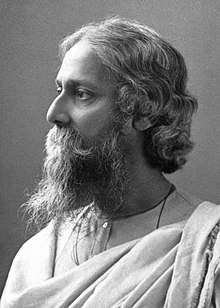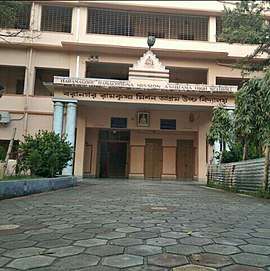Culture of Kolkata
Kolkata has been a pioneering city in Indian renaissance. It has long been known for its literary, artistic and revolutionary heritage. As the former capital of India, and now known as the "Cultural Capital of India", not only Kolkata, but Bengal was the birthplace of modern Indian literary, artistic and scholastic thought. Bengalis tend to have a special appreciation for art and literature; its tradition of welcoming new talent has made it a "city of furious creative energy".[1]
Literature

Bengali prose became modern courtesy of Ishwar Chandra Vidyasagar. The doyens of nineteenth century Bengali literature like Rabindranath Tagore, Michael Madhusudan Dutt, Kazi Nazrul Islam were from Kolkata. Sarat Chandra Chattopadhyay was an author whose speciality was exploring complex human psychology, especially that of female mind. Bankim Chandra Chattopadhyay was one of the earliest Bengali novelists and is popularly known as the author of India's first national song, "Bande Mātarom" (pronounced in Hindi "Vande Mātāram"). Kolkata exemplified by Jibanananda Das, Tarashankar Bandopadhyay, Sukanta Bhattacharya, Bishnu Dey, Premendra Mitra, Buddhadeb Guha etc. Satyajit Ray was also a writer, especially for children. Other literary figures include Sunil Gangopadhyay, Shirshendu Mukhopadhyay, Manik Bandopadhyay, Samaresh Majumdar, Sharadindu Bandyopadhyay, Shankha Ghosh, Amitav Ghosh, Nirad Chaudhuri, Shakti Chattopadhyay, Mahasweta Devi, Joy Goswami, Mani Shankar Mukherjee, etc.
Arts
Dramas and theaters
The city has a long tradition of commercial theatres and group theatres. As opposed to commercial theatres, group theatres usually do not have any profit making agenda. Group theatre activists use the proscenium stage to portray some social message.[2][3] The commercial theatres of the city, however, has been declining in popularity since the 1980s, and only a handful of commercial theatre productions are made, as of 2009.[2][4]
Notable group theatres include the Little Theatre Group, Gandharba, Calcutta Theatre, Nandikar, Bahurupee etc. and movements like the Indian People's Theatre Association (IPTA).[5] Famous drama and theatrics personalities include Ajitesh Bandyopadhyay, Utpal Dutta, Rudraprasad Sengupta and Shambhu Mitra.
Cinema
Music
Cuisine
Architecture
Kolkata has many buildings adorned with Indo-Islamic and Indo-Saracenic architectural motifs. Several well-maintained major buildings from the colonial period have been declared "heritage structures";[6] however, others are in various stages of decay.[7][8] Established in 1814 as the nation's oldest museum, the Indian Museum houses large collections that showcase Indian natural history and Indian art.[9] Marble Palace is a classic example of a European mansion that was built in the city. The Victoria Memorial, a place of interest in Kolkata, has a museum documenting the city's history.
Kalighat painting originated in the 19th century Kolkata, in the vicinity of Kalighat Kali Temple of Kalighat. Initially sold as items of souvenir taken by the visitors to the Kali temple, the paintings over a period of time developed as a distinct school of Indian painting. From the depiction of Hindu gods, goddesses, and other mythological characters, the Kalighat paintings developed to reflect a variety of themes including quotidian life.[10] The Academy of Fine Arts and other art galleries hold regular art exhibitions. The Government College of Art and Craft, founded in 1864, has been the cradle as well as workplace of eminent artists including Abanindranath Tagore, Jamini Roy, and Nandalal Bose.[11] The art college was the birthplace of Bengal school of art that arose as an avant garde and nationalist movement reacting against the prevalent academic art styles.[12][13][14]
Sports
The people of Kolkata are famous for being sports lovers. Cricket and football can easily be called the life blood of the city. The home town of Eden Gardens (headquarters of CAB), the city can boast of an impartial crowd of cricket lovers who cheer for good cricket even when their side is losing. Eden Gardens is one of the biggest stadiums in the country in terms of capacity and witnessed its first test match from 5 to 8 January 1934.[15] Over a football match between archrivals Mohun bagan and East Bengal, the city can get divided. Traditionally, prices of fish soar and drop based on the performances of these two football teams. If Mohun Bagan wins, fans eat prawn to celebrate, whereas hilsa (ilish) is eaten to celebrate an East Bengal victory. Even the football world cup is closely followed in the city with quite a sizeable sports loving population supporting either Brazil or Argentina. One gets to see fans cheering for their favorite teams with all the fervor. Sourav Ganguly, former captain of the Indian Cricket team is from Kolkata.
Exhibitions
Kolkata is a city of exhibitions and fairs. The International History & Heritage Exhibition organised by Sabarna Sangrahashala annually in February is an important event where the rich cultural heritage of the land is reflected.[16] Apart from the history and heritage of India, the exhibition through displays of rarest artifacts and documents portrays the history, traditions and culture of other nations too. The exhibition attracts visitors from all over the world.[17]
References
- Sinha P (1990). "Kolkata and the Currents of History". In Chaudhuriय़यकुहच S. (ed.). Kolkata – The Living City. Volume 1: The Past. Oxford University Press, Oxford.
Cited by: Heierstad G (2003). "Nandikar: Staging Globalisation in Kolkata and Abroad" (PDF). University of Oslo, Norway. p. 102. Archived from the original (PDF Format) on 12 May 2006. Retrieved 26 April 2006. - Bhattacharya, Malini (2005). "Culture". In Bagchi, Jasodhara (ed.). The changing status of women in West Bengal, 1970–2000: the challenge ahead. New Delhi: Sage Publications. pp. 99–100. ISBN 9780761932420. Retrieved 10 February 2012.
- Zarilli, Phillip; McConachie, Bruce; Williams, Gary Jay; Sorgenfrei, Carol Fisher (2010) [2006]. Williams, Gary Jay (ed.). Theatre Histories: An Introduction. Abingdon, UK: Rotledge. pp. 429–430. ISBN 9780415462235. Retrieved 9 March 2012.
- De, Hemchhaya (31 May 2009). "Chowringhee revisited". The Telegraph. Kolkata. Retrieved 9 March 2012.
...most people say that Bengali commercial theatre died in the 1980s...
- Ghosh, Parimal (2012). "Rise and fall of Calcutta's group theatre: the end of a political dream" (PDF). Economic & Political Weekly. Economic and Political Weekly. 47 (10): 36–42. ISSN 0012-9976. Retrieved 9 March 2012.
- "Graded list of heritage buildings" (PDF). Kolkata Municipal Corporation. 2009. Retrieved 24 January 2012.
- Mukherjee Pandey, Jhimli (4 September 2011). "Heritage buildings need restoration, not mere repairs". Times of India. New Delhi. Archived from the original on 17 July 2012. Retrieved 24 January 2012.
- "Out of elite list, cradle of Bengal Renaissance falling apart". Times of India. New Delhi. TNN. 26 June 2011. Archived from the original on 16 July 2012. Retrieved 24 January 2012.
- Mandal, Caesar (14 August 2010). "Gardeners to guard museum?". Times of India. New Delhi. Archived from the original on 7 July 2012. Retrieved 24 January 2012.
- Chaitanya, Krishna (1994). A history of Indian painting: the modern period. New Delhi: Abhinav Publications. pp. 112–118. ISBN 9788170173106.
- "A journey through 145 years". Government College of Art and Craft. Archived from the original on 20 February 2012. Retrieved 29 January 2012.
- Mitter, Partha (1994). "How the past was salvaged by Swadeshi artists". Art and nationalism in colonial India, 1850–1922: occidental orientations. Cambridge, UK: Cambridge University Press. pp. 267–306. ISBN 9780521443548. Retrieved 8 March 2012.
- Onians, John (2004). Atlas of world art. London: Laurence King Publishing. p. 304. ISBN 9781856693776. Retrieved 8 March 2012.
- Ghose, Archana Khare (12 February 2012). "For many art lovers, it's back to the old school". Times of India. New Delhi. Retrieved 8 March 2012.
- "The Cricket Association Of Bengal". www.cricketassociationofbengal.com. Retrieved 30 April 2018.
- http://kamdev.faithweb.com/photo2_2.html
- Bangiya Sabarna Katha Kalishetra Kalikatah by Bhabani Roy Choudhury, Manna Publication. ISBN 81-87648-36-8
